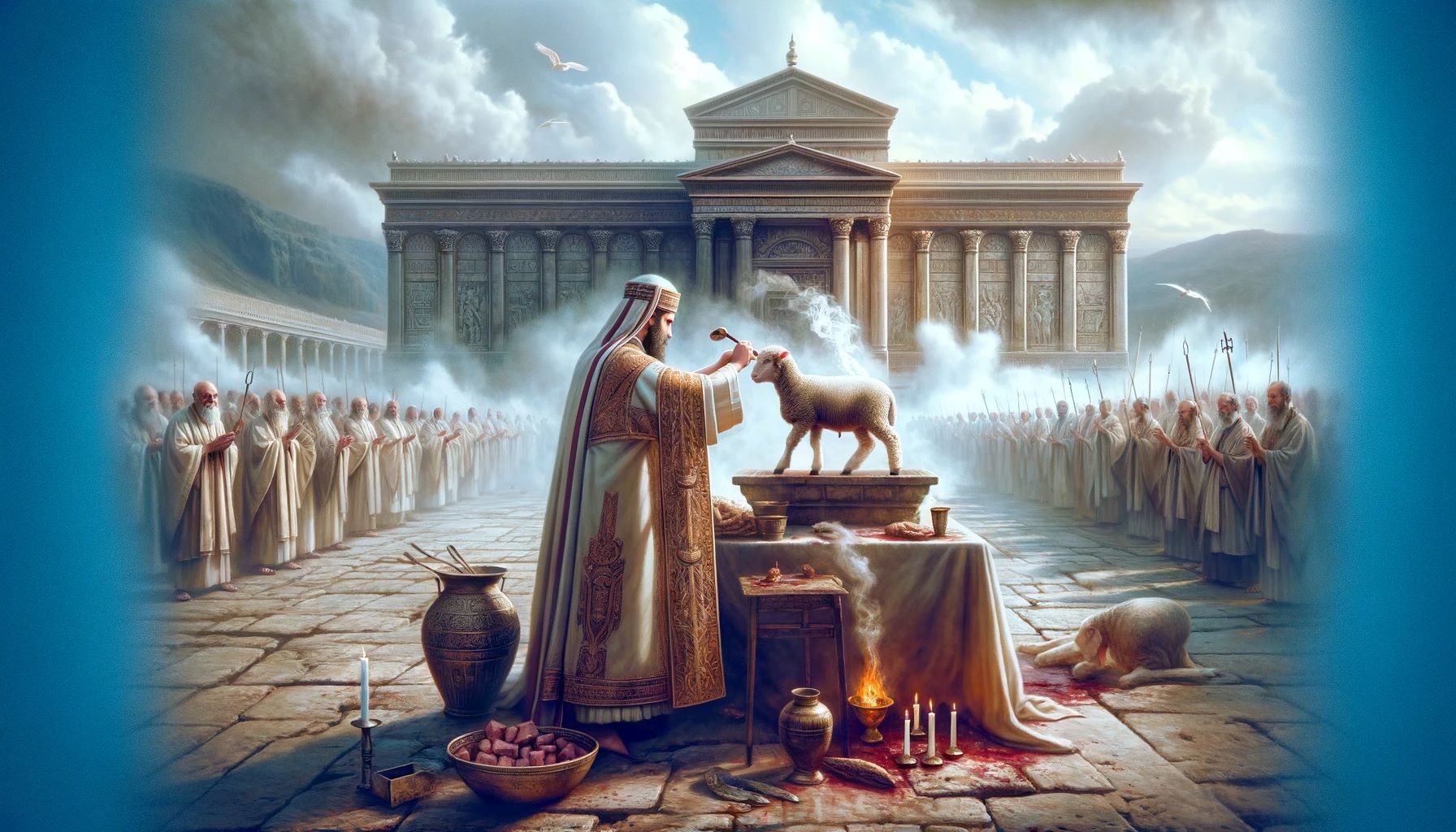Home>Theology and Spirituality>What Is The Atonement And Where In The Old Testament Is This Referred To In Prophecy Seven Times


Theology and Spirituality
What Is The Atonement And Where In The Old Testament Is This Referred To In Prophecy Seven Times
Published: February 10, 2024
Ericka Andersen, an editor at Christian.net, expertly merges digital strategy with content creation, focusing on faith and societal issues. Her communication skills enhance the platform's engaging narratives, fostering meaningful dialogue on belief's impact on society.
Discover the significance of the Atonement and its prophetic references in the Old Testament. Explore theology and spirituality in this insightful discussion.
(Many of the links in this article redirect to a specific reviewed product. Your purchase of these products through affiliate links helps to generate commission for Christian.net, at no extra cost. Learn more)
Table of Contents
Introduction
The concept of atonement holds profound significance in theology and spirituality, transcending various religious traditions and belief systems. At its core, the atonement represents the reconciliation between humanity and the divine, often symbolizing the restoration of harmony and the redemption of sin. This fundamental principle is particularly prominent in Christianity, where the atoning sacrifice of Jesus Christ is regarded as a pivotal event in human history.
The term "atonement" itself encompasses a rich tapestry of meanings, encapsulating themes of forgiveness, redemption, and divine love. It serves as a bridge between the flawed nature of humanity and the perfect righteousness of the divine, offering a pathway to spiritual renewal and reconciliation. Understanding the depth and significance of the atonement requires delving into the theological underpinnings and exploring its portrayal in sacred texts.
Throughout history, the concept of atonement has been a source of contemplation, inspiration, and theological discourse. It has sparked profound reflections on the nature of sin, the character of God, and the ultimate purpose of human existence. As such, the atonement stands as a cornerstone of spiritual reflection and contemplation, inviting individuals to ponder the mysteries of divine grace and the transformative power of redemption.
In the subsequent sections of this article, we will embark on a journey to unravel the multifaceted layers of the atonement, delving into its theological significance and exploring its portrayal in the Old Testament. By examining the prophecies that foreshadow the atonement, we aim to illuminate the profound interconnectedness between the Old Testament and the redemptive narrative of the New Testament. Through this exploration, we seek to gain a deeper appreciation for the timeless relevance and enduring significance of the atonement in shaping the human understanding of spirituality and divine grace.
Read more: Where Is Baptism In The Old Testament
Understanding the Atonement
The concept of atonement holds a central position in theological discourse, embodying a profound and multifaceted understanding of divine reconciliation and redemption. At its essence, the atonement signifies the reconciliation of humanity with the divine, addressing the inherent separation caused by sin and transgression. This reconciliation is often depicted as a divine act of love and grace, bridging the chasm between human fallibility and the perfection of the divine.
The theological significance of the atonement is rooted in the recognition of human frailty and the universal experience of sin. It acknowledges the moral and spiritual imperfections that permeate human existence, underscoring the need for redemption and restoration. In this context, the atonement serves as a transformative mechanism, offering a pathway to spiritual renewal and the restoration of harmonious communion with the divine.
Central to the understanding of the atonement is the sacrificial motif, which permeates various religious traditions and spiritual narratives. In Christianity, the atoning sacrifice of Jesus Christ is regarded as the ultimate expression of divine love and redemptive grace. His willing sacrifice is seen as a profound demonstration of solidarity with humanity, bearing the weight of human sin and offering a pathway to reconciliation with God.
Moreover, the atonement encompasses the themes of justice and mercy in a harmonious tension. It reflects the divine justice in addressing the consequences of sin while simultaneously manifesting divine mercy in offering a means of redemption. This intricate balance between justice and mercy underscores the profound nature of the atonement, portraying a divine response to the complexities of human moral culpability and the yearning for spiritual restoration.
Furthermore, the atonement is intricately linked to the concept of vicarious atonement, wherein the redemptive act of Jesus Christ is understood as a substitutionary sacrifice on behalf of humanity. This theological framework emphasizes the selfless nature of Christ's sacrifice, portraying it as a redemptive offering that transcends individual sin and extends to the collective salvation of humanity.
In essence, the understanding of the atonement encompasses a rich tapestry of theological themes, including reconciliation, redemption, sacrificial love, justice, and mercy. It invites contemplation on the profound mysteries of divine grace and the transformative power of redemption, resonating deeply with the human longing for spiritual renewal and communion with the divine.
The Atonement in the Old Testament
The concept of atonement in the Old Testament is deeply rooted in the sacrificial rituals and practices prescribed within the religious framework of ancient Israel. Atonement, in this context, pertains to the process of reconciliation between humanity and the divine, often mediated through the offering of sacrifices and the observance of sacred rituals. The Old Testament portrays a vivid tapestry of atoning practices, emphasizing the significance of ritual purity, moral rectitude, and the restoration of harmonious communion with God.
Central to the Old Testament understanding of atonement are the rituals of animal sacrifices, particularly those performed by the Levitical priesthood. These sacrificial offerings, including sin offerings, burnt offerings, and peace offerings, were integral to the process of atonement, symbolizing the expiation of sin and the restoration of divine favor. The shedding of blood in these rituals signified the gravity of sin and the need for reconciliation, serving as a tangible expression of the human longing for spiritual restoration.
Moreover, the Day of Atonement, or Yom Kippur, occupies a central position in the Old Testament narrative of atonement. This sacred observance, detailed in the book of Leviticus, delineates a comprehensive ritual of purification and atonement for the entire community of Israel. The elaborate ceremonies, including the offering of sacrifices, the scapegoat ritual, and the purification of the sanctuary, underscore the profound significance of atonement in the religious consciousness of ancient Israel.
The Old Testament also emphasizes the moral and ethical dimensions of atonement, intertwining the concept with the imperative of repentance and the pursuit of righteousness. The prophetic exhortations for genuine repentance and ethical conduct reflect the intrinsic connection between atonement and moral renewal, highlighting the transformative potential of divine reconciliation in shaping human behavior and spiritual disposition.
In essence, the Old Testament presents a rich tapestry of atoning practices and theological reflections, underscoring the profound significance of reconciliation and divine favor within the religious consciousness of ancient Israel. The rituals, sacrifices, and moral imperatives associated with atonement serve as a testament to the enduring human yearning for spiritual renewal and the restoration of harmonious communion with the divine.
Prophecies of the Atonement in the Old Testament
The Old Testament is replete with prophetic references that foreshadow the redemptive significance of the atonement, offering profound insights into the divine plan for reconciliation and spiritual renewal. These prophecies, dispersed across various books and passages, serve as poignant heralds of the atoning work that finds its fulfillment in the New Testament narrative.
One of the most striking prophecies of the atonement is found in the book of Isaiah, often referred to as the "Suffering Servant" passage. In Isaiah 53, the prophetic depiction of a suffering servant who bears the infirmities and transgressions of humanity resonates deeply with the redemptive narrative of the atonement. The poignant imagery of a sacrificial figure who willingly endures suffering for the sake of others encapsulates the profound selflessness and redemptive nature of the atoning work.
Furthermore, the prophetic utterances in the Psalms, particularly in Psalm 22, offer a compelling portrayal of a suffering yet triumphant figure whose redemptive work reverberates across the ages. The vivid imagery of forsakenness and ultimate vindication encapsulates the transformative power of the atonement, portraying a narrative of suffering, redemption, and divine exaltation.
The book of Zechariah also contains prophetic references that anticipate the redemptive dimensions of the atonement. In Zechariah 12:10, the prophecy of a pierced one evokes profound parallels with the sacrificial motif of the atonement, offering a glimpse into the transformative impact of a redemptive act that transcends individual suffering and extends to the collective reconciliation of humanity.
Moreover, the prophetic imagery in the book of Daniel, particularly in Daniel 9:26, alludes to the redemptive significance of atoning sacrifice, underscoring the temporal and transcendent dimensions of divine reconciliation. The prophetic anticipation of a decisive atoning work resonates with the overarching narrative of divine grace and redemptive love that finds its fulfillment in the atoning sacrifice of Jesus Christ.
In essence, the prophetic references to the atonement in the Old Testament serve as poignant heralds of the redemptive narrative that unfolds in the New Testament. These prophecies offer profound insights into the divine plan for reconciliation and spiritual renewal, illuminating the enduring significance of the atonement in shaping the human understanding of divine grace and redemptive love.
The Seven References to the Atonement in Prophecy
The Old Testament contains a tapestry of prophetic references that intricately foreshadow the redemptive significance of the atonement, offering profound insights into the divine plan for reconciliation and spiritual renewal. Seven distinct references stand out as poignant heralds of the atoning work that finds its fulfillment in the New Testament narrative, each contributing to a rich mosaic of prophetic anticipation.
-
Isaiah 53:5 – "But he was pierced for our transgressions, he was crushed for our iniquities; the punishment that brought us peace was on him, and by his wounds we are healed." This prophetic portrayal of a suffering servant who bears the burdens of humanity's transgressions encapsulates the profound selflessness and redemptive nature of the atoning work, laying the foundation for the transformative power of divine reconciliation.
-
Psalm 22:16 – "Dogs surround me, a pack of villains encircles me; they pierce my hands and my feet." The vivid imagery of forsakenness and ultimate vindication in this prophetic passage resonates deeply with the redemptive narrative of the atonement, portraying a compelling narrative of suffering, redemption, and divine exaltation that reverberates across the ages.
-
Zechariah 12:10 – "And I will pour out on the house of David and the inhabitants of Jerusalem a spirit of grace and supplication. They will look on me, the one they have pierced, and they will mourn for him as one mourns for an only child, and grieve bitterly for him as one grieves for a firstborn son." This prophetic reference evokes profound parallels with the sacrificial motif of the atonement, offering a glimpse into the transformative impact of a redemptive act that extends to the collective reconciliation of humanity.
-
Daniel 9:26 – "After the sixty-two 'sevens,' the Anointed One will be put to death and will have nothing. The people of the ruler who will come will destroy the city and the sanctuary. The end will come like a flood: War will continue until the end, and desolations have been decreed." The prophetic anticipation of a decisive atoning work resonates with the overarching narrative of divine grace and redemptive love, underscoring the temporal and transcendent dimensions of divine reconciliation.
-
Isaiah 53:10 – "Yet it was the Lord's will to crush him and cause him to suffer, and though the Lord makes his life an offering for sin, he will see his offspring and prolong his days, and the will of the Lord will prosper in his hand." This prophetic portrayal of the redemptive sacrifice, ordained by divine will, illuminates the profound interconnectedness between suffering, sacrifice, and the ultimate triumph of redemptive love.
-
Isaiah 53:12 – "Therefore I will give him a portion among the great, and he will divide the spoils with the strong, because he poured out his life unto death, and was numbered with the transgressors. For he bore the sin of many, and made intercession for the transgressors." This prophetic reference encapsulates the transformative impact of the atoning sacrifice, portraying a narrative of selfless intercession and redemptive triumph that reverberates across the annals of human history.
-
Psalm 16:10 – "because you will not abandon me to the realm of the dead, nor will you let your faithful one see decay." This prophetic anticipation of triumphant vindication and the conquest of death resonates deeply with the redemptive narrative of the atonement, offering a glimpse into the transformative power of divine reconciliation and the enduring triumph of redemptive love.
In essence, these seven references to the atonement in prophecy form a profound tapestry of prophetic anticipation, offering poignant insights into the divine plan for reconciliation and spiritual renewal. They illuminate the enduring significance of the atonement in shaping the human understanding of divine grace and redemptive love, serving as timeless heralds of the transformative power of divine reconciliation.
Read more: Where Is Jesus Christ In The Old Testament
Conclusion
In conclusion, the concept of atonement stands as a profound testament to the enduring human longing for spiritual renewal and reconciliation with the divine. From its rich portrayal in the Old Testament to the poignant prophecies that anticipate its redemptive significance, the atonement encapsulates the transformative power of divine grace and sacrificial love. The Old Testament provides a vivid tapestry of atoning practices, emphasizing the significance of ritual purity, moral rectitude, and the restoration of harmonious communion with God. The rituals, sacrifices, and moral imperatives associated with atonement serve as a testament to the enduring human yearning for spiritual renewal and the restoration of divine favor.
Moreover, the prophetic references to the atonement in the Old Testament offer profound insights into the divine plan for reconciliation and spiritual renewal. The seven distinct references to the atonement in prophecy form a profound tapestry of prophetic anticipation, illuminating the enduring significance of the atonement in shaping the human understanding of divine grace and redemptive love. These prophecies serve as timeless heralds of the transformative power of divine reconciliation, offering poignant insights into the divine plan for reconciliation and spiritual renewal.
The atonement, with its themes of reconciliation, redemption, sacrificial love, justice, and mercy, invites contemplation on the profound mysteries of divine grace and the transformative power of redemption. It resonates deeply with the human longing for spiritual renewal and communion with the divine, offering a pathway to spiritual renewal and the restoration of harmonious communion with the divine. The atonement, with its profound interconnectedness between the Old Testament and the redemptive narrative of the New Testament, stands as a cornerstone of spiritual reflection and contemplation, inviting individuals to ponder the mysteries of divine grace and the transformative power of redemption.
In essence, the atonement transcends theological discourse and spiritual traditions, embodying the universal yearning for reconciliation, redemption, and divine love. Its enduring significance resonates across the annals of human history, offering a timeless testament to the transformative power of divine grace and the redemptive triumph of sacrificial love.














